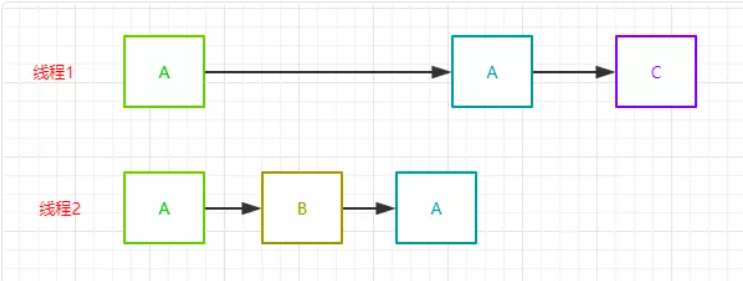brief introduction
AtomicStampedReference is an atomic class provided under the java concurrency package. It can solve ABA problems that cannot be solved by other atomic classes, such as AtomicInteger ABA problem
ABA
The ABA problem occurs in a multithreaded environment. When a thread reads the same memory address twice in a row and gets the same value twice, it simply thinks that "the value of this memory address has not been modified". However, at the same time, another thread may change the value of this memory address from a to B and back to A. at this time, it simply thinks that "Not modified" is obviously wrong.
For example, two threads execute in the following order:
(1) Thread 1 reads the value of memory location X as A;
(2) Thread 1 is blocked;
(3) Thread 2 reads the value of memory location X as A;
(4) Thread 2 modifies the value of memory location X to B;
(5) Thread 2 modifies the value of memory location X to A;
(6) Thread 1 recovers and continues to execute. After comparison, it is found that A sets the value of memory location X to C;

It can be seen that for thread 1, the first A and the second A are not actually the same A.
ABA problems usually occur in a lock free structure. The above process is represented by code, which is roughly like this:
public static void main(String[] args) {
AtomicInteger atomicInteger = new AtomicInteger(1);
new Thread(new Runnable() {
@Override
public void run() {
int value = atomicInteger.get();
System.out.println("Thread 1 read value="+value);
try {
Thread.sleep(10000);
} catch (InterruptedException e) {
e.printStackTrace();
}
if (atomicInteger.compareAndSet(value,3)) {
System.out.println("Thread 1 modification value from"+value+"To 3");
}
}
}).start();
new Thread(new Runnable() {
@Override
public void run() {
int value = atomicInteger.get();
System.out.println("Thread 2 read value="+value);
if (atomicInteger.compareAndSet(value,2)) {
System.out.println("Thread 2 modification value from"+value+"To 2");
value = atomicInteger.get();
System.out.println("Thread 2 read value="+value);
if (atomicInteger.compareAndSet(value,1)){
System.out.println("Thread 2 modification value from"+value+"To 1");
}
}
}
}).start();
}
output
Thread 1 read value=1 Thread 2 read value=1 Thread 2 modification value From 1 to 2 Thread 2 read value=2 Thread 2 modification value From 2 to 1 Thread 1 modification value From 1 to 3
Inner class
AtomicStampedReference
private static class Pair<T> {
final T reference;// Element value
final int stamp; // Version number
private Pair(T reference, int stamp) {
this.reference = reference;
this.stamp = stamp;
}
static <T> Pair<T> of(T reference, int stamp) {
return new Pair<T>(reference, stamp);
}
}
Bind the element value and version number together and store them in the reference and stamp (meaning of stamp and stamp) of Pair.
Construction method
public AtomicStampedReference(V initialRef, int initialStamp) {
// That is, the element value and version number must be passed in during initialization
pair = Pair.of(initialRef, initialStamp);
}
compareAndSet() method
public boolean compareAndSet(V expectedReference,
V newReference,
int expectedStamp,
int newStamp) {
// Gets the current (element value and version number) pair
Pair<V> current = pair;
return
// The element hasn't changed
expectedReference == current.reference &&
// The version number has not changed
expectedStamp == current.stamp &&
// The new reference is equal to the old reference
((newReference == current.reference &&
// The new version number is equal to the old version number
newStamp == current.stamp) ||
// Construct a new Pair object and update it
casPair(current, Pair.of(newReference, newStamp)));
}
private static final sun.misc.Unsafe UNSAFE = sun.misc.Unsafe.getUnsafe();
private static final long pairOffset =
objectFieldOffset(UNSAFE, "pair", AtomicStampedReference.class);
private boolean casPair(Pair<V> cmp, Pair<V> val) {
// Call the compareAndSwapObject() method of Unsafe to update the reference of pair as a new reference
return UNSAFE.compareAndSwapObject(this, pairOffset, cmp, val);
}
(1) If the element value and version number have not changed and are the same as the new one, return true;
(2) If the element value and version number do not change and are not exactly the same as the new pair, construct a new pair object and update the pair by CAS.
- AtomicStampedReference uses version number to solve ABA
case
Use AtomicStampedReference to solve the ABA problem caused by AtomicInteger
public static void main(String[] args) {
AtomicStampedReference<Integer> atomicInteger = new AtomicStampedReference<>(1,1);
int[] stampHolder = new int[1];
new Thread(new Runnable() {
@Override
public void run() {
int value = atomicInteger.get(stampHolder);
// Be sure to save the original value first
int stamp = stampHolder[0];
System.out.println("Thread 1 read value="+value+",stamp="+stampHolder[0]);
try {
Thread.sleep(10000);
} catch (InterruptedException e) {
e.printStackTrace();
}
System.out.println("Thread 1 read value="+value+",stamp="+stampHolder[0]);
// It is changed into stamp to pass in the previous value. If it is stampHolder[0], it is the latest value, which is meaningless
if (atomicInteger.compareAndSet(value,3,stamp,stampHolder[0]+1)) {
System.out.println("Thread 1 modification value from"+value+"To 3"+"stamp from"+stampHolder[0]+"reach"+(stampHolder[0]+1));
}else{
System.out.println("Thread 1 modification failed");
}
}
}).start();
new Thread(new Runnable() {
@Override
public void run() {
int value = atomicInteger.get(stampHolder);
System.out.println("Thread 2 read value="+value+",stamp="+stampHolder[0]);
if (atomicInteger.compareAndSet(value,2,stampHolder[0],stampHolder[0]+1)) {
System.out.println("Thread 2 modification value from"+value+"To 2"+"stamp from"+stampHolder[0]+"reach"+(stampHolder[0]+1));
value = atomicInteger.get(stampHolder);
System.out.println("Thread 2 read value="+value+",stamp="+stampHolder[0]);
if (atomicInteger.compareAndSet(value,1,stampHolder[0],stampHolder[0]+1)){
System.out.println("Thread 2 modification value from"+value+"To 1"+"stamp from"+stampHolder[0]+"reach"+(stampHolder[0]+1));
value = atomicInteger.get(stampHolder);
System.out.println("Thread 2 read value="+value+",stamp="+stampHolder[0]);
}
}
}
}).start();
}
You can see that thread 1 failed to update 1 to 3 at last, because the version number also changed, and the ABA problem was successfully solved.
Thread 2 read value=1,stamp=1 Thread 1 read value=1,stamp=1 Thread 2 modification value From 1 to 2 stamp From 1 to 2 Thread 2 read value=2,stamp=2 Thread 2 modification value From 2 to 1 stamp From 2 to 3 Thread 2 read value=1,stamp=3 Thread 1 read value=1,stamp=3 Thread 1 modification failed
summary
(1) The ABA problem should be paid attention to when using lock free structure in multi-threaded environment;
(2) The solution of ABA is generally controlled by the version number, and ensures that the data structure is transmitted by the element value, and each time an element is added, a new node is created to carry the element value;
(3) AtomicStampedReference uses Pair internally to store the element value and its version number;